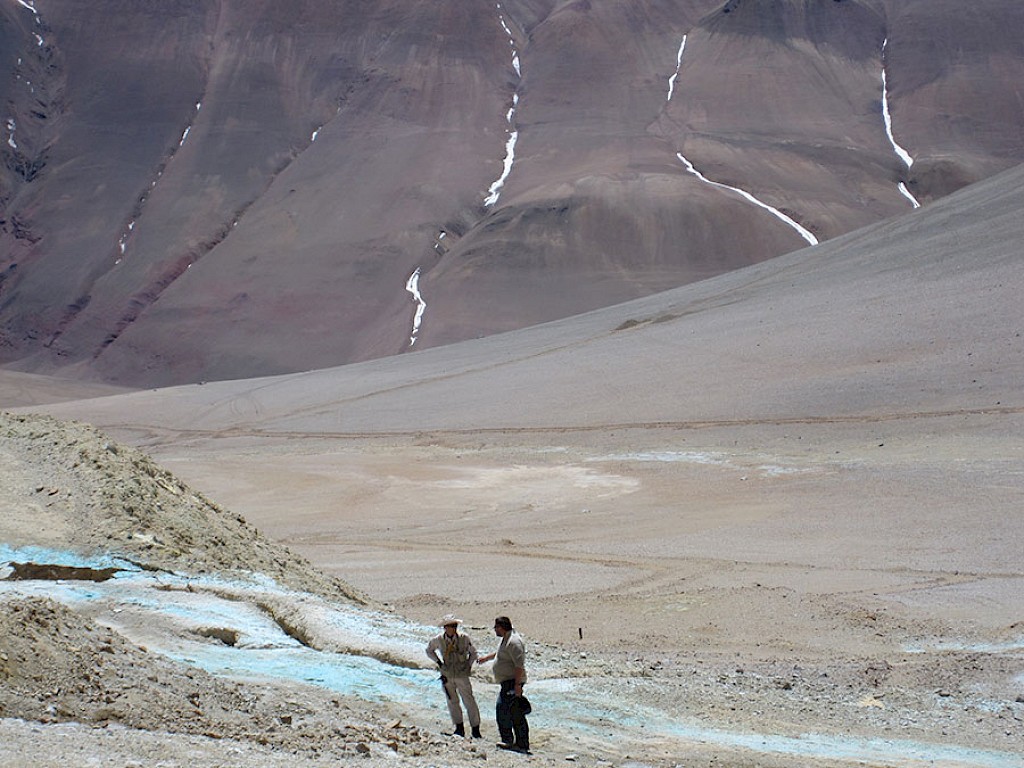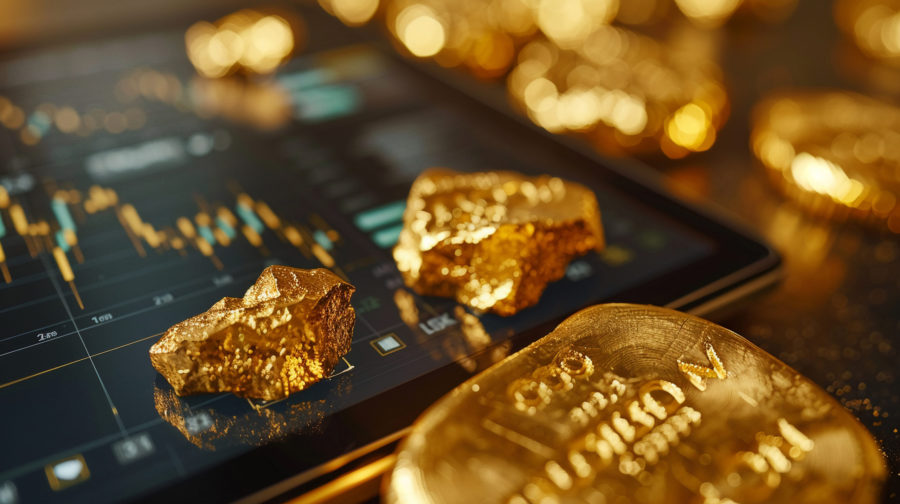Bob Moriarty: Essentially, the news announced on Sept. 18 was Fed Chairman Ben Bernanke putting a stake in the heart of the dollar. He guaranteed its destruction. The move up in gold was a natural, logical move by the shorts to cover.
“The news announced on Sept. 18 was Fed Chairman Ben Bernanke putting a stake in the heart of the dollar.”
Bernanke’s theory that pouring tons of money into the economy will increase employment hasn’t worked since quantitative easing (QE) 1. It is just guaranteeing the destruction of the currency.
I’m not sure what happened on Sept 20. I don’t think gold’s fall that day had anything to do with the government shutting down. I think we had a major bottom in June. Lately, I’m seeing so many bright companies that are so absurdly cheap. It’s a wonderful opportunity for investors.
TGR: Does it matter to the price of gold who chairs the Fed?
BM: No, it doesn’t. It’s similar to asking whether it’s more important whether you die of cancer or of a heart attack.
TGR: You said in an article in 321gold that markets go up and down; you can make a lot of money if you learn to ignore the clutter and noise. How are you adjusting for the volatility in the market today?
BM: Volatility doesn’t bother me. The small, vocal group that has been screaming about gold and silver being manipulated is ignoring the fact that all financial markets are manipulated. The manipulation doesn’t make any difference. It doesn’t give you a buy signal or a sell signal.
We have had extraordinary extremes and bullishness for the Dow and the S&P 500 and extraordinary extremes and bearishness for gold, silver and platinum. You just have to ignore the noise.
The people claiming a manipulation/conspiracy have convinced a lot of people that markets are never supposed to go down. Gold is a good investment and it’s supposed to go up every single day, they said.
Gold is a good investment, but it’s not supposed to go up every single day. No market goes up every single day. It’s not manipulation when markets go down.
TGR: You spent much of the summer touring mine sites. Tell us what got you excited.
BM: Just today I talked with the management and the technical teams at Cayden Resources Inc. (CYD:TSX.V; CDKNF:NASDAQ). When I wrote about the company in May, the stock price was $0.72. It’s around $1.65 today. The stock was cheap at $0.72 and it’s cheap today. This could be a $30 stock. It’s an extraordinary opportunity.
“Lately, I’m seeing so many bright companies that are so absurdly cheap. It’s a wonderful opportunity for investors.”
Cayden has two homeruns. One is Morelos Sur, a project in the Guerrero Gold Belt, in between two gold mines owned by Goldcorp Inc. (G:TSX; GG:NYSE). Unless Goldcorp buys the Cayden project, it will lose 2–3 million ounces (2–3 Moz) of gold. It’s only a question of how much Goldcorp will pay for it. I used to believe it would be $42 million ($42M). Now, it looks as if it will be $100–200M, depending on the price of gold. As of today, Cayden has a total market cap of $70M and an enterprise value of $55M. Yet it could get a check from Goldcorp for $2.50 to $5 a share. The current price is simply nuts.
Cayden also has a project in Jalisco that had been mined before, El Barqueño. The company just started drilling and I think the results will be extraordinary. In May, I predicted it would be a 5 Moz project. I now believe this will be a whole new district.
TGR: Cayden just filed an updated technical report on the Morelos Sur and El Barqueño projects. Did that give you the results you were hoping for?
BM: No, because the technical reports were technical in nature. They didn’t address the resource. What the reports said was true, but it’s not meaningful. When Cayden releases drill results in mid-October, I expect intercepts of 70–100 meters (70–100m) of 3+ grams per ton (3+ g/t) material.
A lot of majors are looking at Cayden right now. This will be one of the major successes of 2013.
TGR: What other companies did you see in Mexico?
BM: I also visited Silver Bull Resources Inc. (SVB:TSX; SVBL:NYSE.MKT). Silver Bull has a really unusual deposit. Silver is a very reactive metal. It’s very common in the silver-gold system to have near-surface silver oxidize and get washed away. There will be lots of gold, but no silver at surface. The majority of this deposit is silver oxide.
TGR: Silver Bull uses its SART (Sulfidization, Acidification, Recycling and Thickening) process for extracting silver and zinc. Once the feasibility of the metallurgy is proven, would this company also be a takeover target?
BM: Absolutely. You have to process silver oxide differently than silver sulfides. It’s very typical in a heap leach to have 50% or 60% recovery of silver. You could recover more if you used more cyanide, but that costs money and in most cases it’s not worth it. The SART process recovers cyanide. While it’s not a cheap process for Silver Bull, it will be a very important technical issue. In the next six months, when the silver price goes through $25/oz, I expect an offer for Silver Bull will be considerably higher than the stock is now.
TGR: You also spent a week in Nevada. What did you see there?
BM: I went to see a project I first visited 12 years ago called Kinsley Mountain, owned by Pilot Gold Inc. (PLG:TSX). It was first put into production in 1994 and went out of production in 1999.
“Gold is a good investment, but it’s not supposed to go up every single day. No market goes up every single day.”
Kinsley Mountain is one of those projects that may be a Long Canyon-type project—which would be 2, 5, even 10 Moz—or not. Even if it’s not a Long Canyon, it would still be 500,000 oz (500 Koz), and could still sell. It won’t cost Pilot Gold anything to drill, because the company can recover the money.
Pilot’s management team is the best in the industry, with most members coming from Fronteer Gold. When Newmont Mining Corp. (NEM:NYSE) bought Fronteer out for $2.3 billion ($2.3B), it was an absolute homerun for shareholders. Pilot is doing the same thing. You’re buying at a 60% discount to what it was nine months ago.
A year ago, I visited Pilot Gold’s projects in Turkey. One is a copper-gold porphyry; the other is a gold-silver epithermal system. Both were very attractive and had great technical success and great drill results. The stock went from $1.30 last year to $2.40 in January 2013. Then, it got knocked down to about $0.71. After the shenanigans of last week, it was up to $1.10 and it’s back below $1 now.
It’s important for your readers to understand that the decline in shares since January has not been rational. Nor has it been manipulation or shorting. It’s been hedge funds and gold mutual funds being forced to sell shares. Often, they sold the best projects just because they could. They needed cash and sold everything they could to raise it.
TGR: Where is Pilot Gold’s focus, in Turkey or Nevada?
BM: It’s focused on both locations and all three projects. The company’s joint venture with Teck Resources Ltd. (TCK:TSX; TCK:NYSE) on the big porphyry project in Turkey is in a holding pattern. It’s not attractive at $3/lb copper, but it’s very attractive at $4/lb copper.
The company is drilling the heck out of the TV Tower project and Kinsley Mountain. It has plenty of cash and an incredible ability to raise money.
TGR: What else did you see in Nevada, Bob?
BM: There are three projects in the Walker Lane Trend, which runs parallel to the Nevada/California/Arizona border, between Las Vegas and Reno. The Comstock Lode and Round Mountain gold mines are both in the Walker Lane Trend.
I visited Star Gold Corp. (SRGZ:OTCQB), which is extremely tightly held. The company is moving forward with production plans for 2016. The repetitive drill-and-raise-money approach has proven to be a flawed business model. Star Gold’s management wants to get into production. The company has 250 Koz gold that can be heap leached.
One of my suggestions to management was that the company needed to be a little more liquid so people could buy and sell. I hope it will do that. The company is doing a $1M placement now. I think it will do fine.
I also visited Walker River Resources Corp. (WRR:TSX.V). Its Lapon Canyon high-grade gold project had been privately held for about 70 years, and nothing had been done in that time. The company went public in July 2012. Walker River has good grades and a good technical team. It has a very tight share structure and very small number of shares.
Star Gold is going after the low-grade, bulk tonnage and Walker River is going after the high-grade vein structures. I think both will succeed. Both are focused on production.
TGR: How will companies in these historic areas succeed when others couldn’t before? Is it new technology? Is it the price of gold?
BM: Both Walker River and Star Gold are projects that have never been drill tested.
At Round Mountain, the most gold is found in type 2 rock, which is volcanic tuffs, similar to a sponge. It’s very easy rock to leach. The liquid containing the gold goes through the rock and the gold that’s left is very easy to mine.
Star Gold has a bigger percentage of type 2 rock than Round Mountain, which makes the company attractive. I like the idea of getting into production cheaply. The company has a very loyal, very tight group of shareholders. The only proviso is that the stock will be very difficult to buy.
Walker River, on the other hand, has about 15M shares outstanding, selling for about $0.15/share. It easily has tenbagger potential and it is easy to buy and sell.
TGR: Anything else in Nevada?
BM: I talked to the technical team from NuLegacy Gold Corporation (NUG:TSX.V). It is near Elko and has a joint venture with Barrick Gold Corp. (ABX:TSX; ABX:NYSE). NuLegacy has 70% of the project; Barrick 30%. NuLegacy has $5M to spend in a certain period of time. The company has spent about half and has produced very attractive results.
Management has to figure out a strategic issue: Does it want Barrick to back in or not? If Barrick backs in, Barrick will have to spend three times what NuLegacy spent; it will have to spend $15M in a five-year period and NuLegacy would get a 30% carried interest to production. In effect, NuLegacy would get a free ride. From a strategic point of view that’s brilliant; Barrick puts the mine into production and NuLegacy gets 30%.
The problem is that NuLegacy could go for several years with no news for investors. That hurts the share price. The alternative is for NuLegacy to drill some areas that are not that good to discourage Barrick, in which case NuLegacy would get 70%.
NuLegacy gets a homerun at 70% or 30%. How aggressively the company drills is the technical issue right now.
TGR: I visited there a year ago and the big topic of conversation was being in a trend with visual lines of sight to working gold mines. There are many trends in Nevada; are they turning out to be good indicators of where gold is being found?
BM: In Star Gold’s case, absolutely, but that’s not always true.
Walker Lane is hundreds of miles long. Ninety percent of it doesn’t hold much, but 10% holds something very, very good.
TGR: Are you following other Nevada companies?
BM: There is Comstock Mining Inc. (LODE:NYSE.MKT), which continues to produce. The company is growing, adding to its resource. It produces 25 Koz of gold equivalent. It needs to increase that to do something for the shareholders.
TGR: What about outside Nevada?
BM: Resource nationalization has produced some interesting results. Gold companies deliberately, and mistakenly, underestimated their costs of production. When countries like Mongolia, Tanzania, Peru, Bolivia and Ecuador saw the gold price hit $1,900/oz, they reacted by saying, “These companies are making so much money, we need to take a big chunk of it.” As a result, there have been tens of billions of dollars in write-offs.
Kinross Gold Corp. (K:TSX; KGC:NYSE) wrote off $2.3B in Ecuador because the Ecuadorean government demanded 80% of the project. Kinross said that it funds 100% of the mine, so if it gives 80% to the government, it can’t make any money. The government didn’t budge. Kinross walked away. That was a smart move on its part.
TGR: Which countries not experiencing resource nationalization would you rather be in?
BM: The location of a resource is increasingly important. The top three safest jurisdictions in order are probably Canada, Mexico and the U.S.
You need to remember that every country in the world has been spending money that it doesn’t have. They are broke. The entire financial system is broke. Governments are doing whatever they can to beg, borrow or steal money. In the case of resource nationalization, they’re going to steal it. What they’re doing is long-term negative for the countries, but they don’t care.
TGR: Is that the case in Peru?
BM: Peru keeps making noises, but mining is the number one industry in Peru. I visited Peruvian Precious Metals Corp. (PPX:TSX.V; PPX:BVL), but it was called Sienna Gold when I was there. It needs to raise money and do more drilling in a difficult environment, in a difficult country. But the management is strong and it can deliver.
TGR: The company needs to show technical results and rebrand the company to regain trust in management, correct?
BM: Absolutely correct. The prior management was utterly incompetent.
But I must say that for the last two years it’s been very difficult for anyone to raise money. The good companies, like Cayden, Pilot Gold and Almaden Minerals Ltd. (AMM:TSX; AAU:NYSE), have such strong management that they can raise money. But they’re paying a price. It’s not cheap.
TGR: Where else have your travels taken you?
BM: Recently I made another quick trip to Chile to visit an interesting company listed in Australia namedHot Chili Ltd. (HCH:ASX). It is a production oriented company. The biggest problem in the copper arena right now is the number of low-grade, high-capex projects. There is a world of projects needing in excess of a billion dollars that work at $4/lb copper but not at $2.50/lb copper.
Hot Chili pulled off a coup in Chile in the middle of the Atacama Desert. Chile is an interesting country to work in. In 1970 the government nationalized the biggest copper mines and distributed the most potential copper ground to the state copper company, CODELCO, and the state iron company, CAP S.A. Small mines were left to the existing small owners and operators. In the case of what Hot Chili has named the La Productora project there was a core, high-grade copper mine surrounded by both CODELCO and CAP S.A. Ground. Hot Chili recognized that if all three segments were put together, they could have a large, high-grade copper project right in the middle of existing infrastructure. It took years but Hot Chili put it together and did deals with all three parties.
Hot Chili nearly doubled its resource in 2013 with a Joint Ore Reserves Committee (JORC) resource of 165 million tonnes (165 Mt) of mineralization and a high-grade core of 53 Mt. The company is in the midst of a 100,000-meter drill program and intends to complete another resource upgrade in late 2013. It is moving forward with the intent to go into production in 2017 with both copper and iron. The project has a low capex required of between $500M and $700M. The company is fully funded.
TGR: You’ve talked before about Mundoro Capital Inc. (MUN:TSX.V). It recently released trench sample results on a project in Serbia. Were you surprised when the stock price went down?
BM: Yes, I was. Mundoro had $0.36/share of cash when it started its drill program. Now, you can buy the shares for $0.30/share. You’re paying nothing for the deposit. The company has good management and an extraordinary technical team. It trenched 12m at 30 g/t gold. Then the gold price went down.
TGR: Is this a situation where, if the gold price goes up, the stock price will rise as well?
BM: Here’s what’s crazy. You’re buying dollar bills for $0.90 and investors don’t want to do it. That is as close to an absolutely sure sign of a bottom I’ve ever seen. It happened in 2001 and in 2008. It’s happening now and it’s utterly irrational.
TGR: Normally, gold prices go back up cyclically in the fall. Does that trend still apply or is the price all over the place because we had a bumpy summer?
BM: We did have a very rough summer, with a low for gold and gold shares at the end of June. I think we’ve seen a bottom.
Everybody is terrified of buying gold. That’s totally nuts. Everybody should run to the bank, take out all their money and put it in gold.
TGR: That sounds like the perfect ending for a Gold Report interview. Thanks for your time and insights.
Bob Moriarty and Barb Moriarty brought 321gold.com to the Internet almost 10 years ago. They later added 321energy.com to cover oil, natural gas, gasoline, coal, solar, wind and nuclear energy. Both sites feature articles, editorial opinions, pricing figures and updates on current events affecting both sectors. Previously, Bob was a Marine F-4B and O-1 pilot with more than 820 missions in Vietnam. He holds 14 international aviation records.
Want to read more Gold Report interviews like this? Sign up for our free e-newsletter, and you’ll learn when new articles have been published. To see a list of recent interviews with industry analysts and commentators, visit our Streetwise Interviews page.
DISCLOSURE:
1) JT Long conducted this interview for The Gold Report and provides services to The Gold Report as an employee. She or her family own shares of the following companies mentioned in this interview: None.
2) The following companies mentioned in the interview are sponsors of The Gold Report: Almaden Minerals Inc., Cayden Resources Inc., Goldcorp Inc., Silver Bull Resources Inc., Pilot Gold Inc., Walker River Resources Corp., Peruvian Precious Metals Corp., Comstock Mining Inc., Hot Chili Ltd. and Mundoro Capital Inc. Streetwise Reports does not accept stock in exchange for its services or as sponsorship payment.
3) Bob Moriarty: I or my family own shares of the following companies mentioned in this interview: Walker River Resources Corp. and Star Gold Corp. I personally am or my family is paid by the following companies mentioned in this interview: None. My company has a financial relationship with the following companies mentioned in this interview: Cayden Resources Inc., Silver Bull Resources Inc., Pilot Gold Inc., Walker River Resources Corp., Star Gold Corp. and Mundoro Capital Inc. I was not paid by Streetwise Reports for participating in this interview. Comments and opinions expressed are my own comments and opinions. I had the opportunity to review the interview for accuracy as of the date of the interview and am responsible for the content of the interview.
4) Interviews are edited for clarity. Streetwise Reports does not make editorial comments or change experts’ statements without their consent.
5) The interview does not constitute investment advice. Each reader is encouraged to consult with his or her individual financial professional and any action a reader takes as a result of information presented here is his or her own responsibility. By opening this page, each reader accepts and agrees to Streetwise Reports’ terms of use and full legal disclaimer.
6) From time to time, Streetwise Reports LLC and its directors, officers, employees or members of their families, as well as persons interviewed for articles and interviews on the site, may have a long or short position in securities mentioned and may make purchases and/or sales of those securities in the open market or otherwise.

 Opining that Fed Chairman Ben Bernanke has put a stake in the heart of the dollar, Bob Moriarty of 321gold advises people to invest in something real or be prepared to see their investments go to money heaven. Attributing many of the declines in share prices to irrational behavior, he tells
Opining that Fed Chairman Ben Bernanke has put a stake in the heart of the dollar, Bob Moriarty of 321gold advises people to invest in something real or be prepared to see their investments go to money heaven. Attributing many of the declines in share prices to irrational behavior, he tells 


